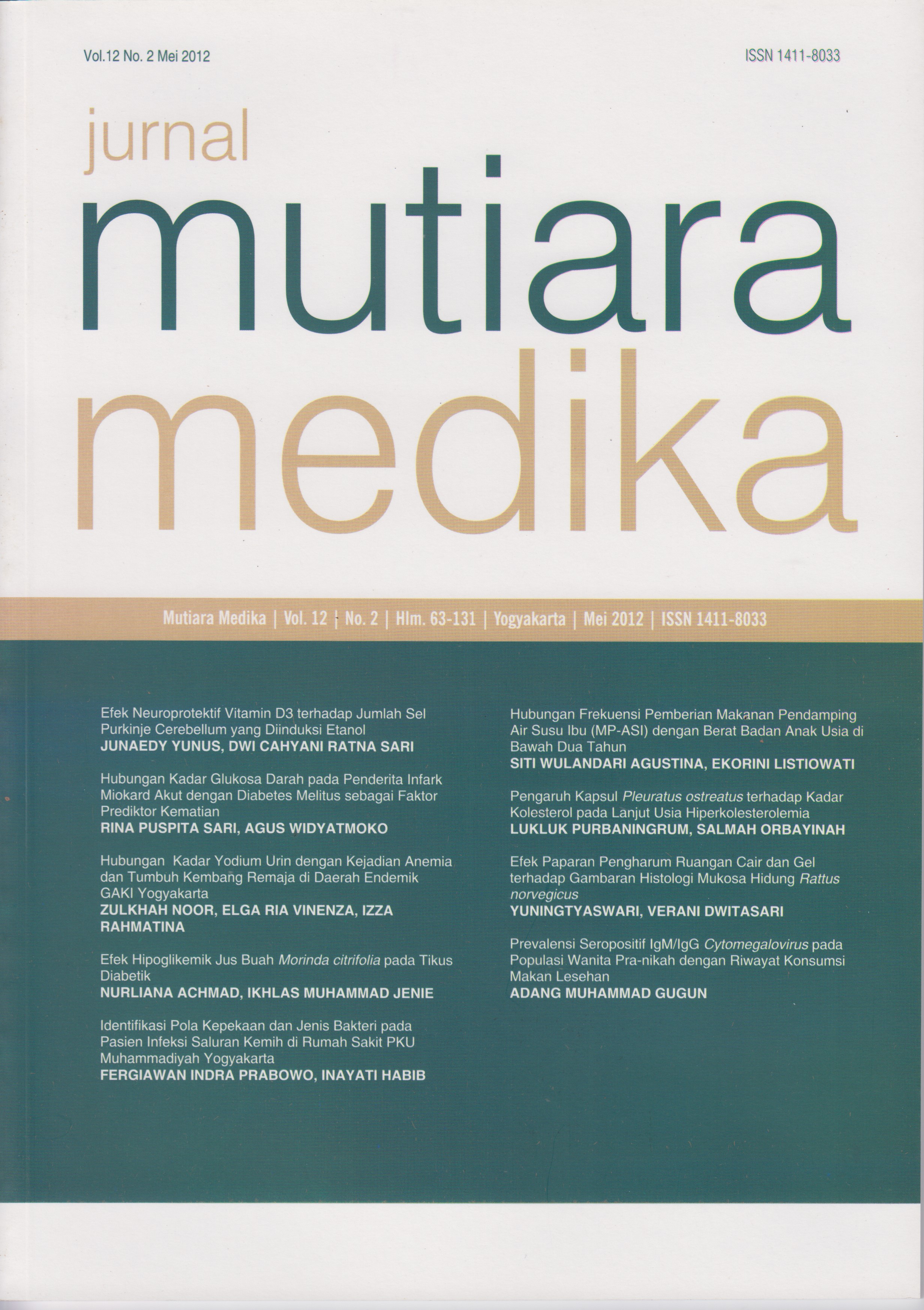Hubungan Frekuensi Pemberian Makanan Pendamping Air Susu Ibu (MP-ASI) dengan Berat Badan Anak Usia di Bawah Dua Tahun
DOI:
https://doi.org/10.18196/mmjkk.v12i2.1011Keywords:
pemberian MP-ASI, berat badan anak, status gizi, giving complementary feeding, children body weight, nutrition statusAbstract
Pemberian Makanan Pendamping Air Susu Ibu (MP-ASI) yang tidak sesuai dengan kebutuhan anak dan pola asuh, akan menyebabkan gangguan tumbuh kembang anak pada usia 12-24 bulan. Berat badan anak dapat digunakan untuk menggambarkan status gizi seseorang maka berat badan akan bertambah mengikuti pertambahan umur. Tujuan penelitian ini adalah untuk menganalisis hubungan frekuensi pemberian makanan pendamping Air Susu Ibu (MP-ASI) dengan berat badan anak usia di bawah dua tahun di wilayah kerja Puskesmas Kraton Yogyakarta. Jenis penelitian ini adalah observasional analitik dengan pendekatan cross sectional. Populasi adalah ibu yang mempunyai anak berusia di bawah dua tahun di Puskesmas Kraton Yogyakarta. Sampel 36 orang. Data dianalisis menggunakan uji Chisquare dan hasil perhitungan diperoleh 2hitung = 14,592 > 2tabel = 12,592, sehingga terdapat hubungan frekuensi pemberian MP-ASI dengan peningkatan berat badan anak usia di bawah dua tahun dengan didapatkan nilai signifikansi p=0,024 (p < 0,05). Disimpulkan bahwa semakin tinggi frekuensi pemberian MP-ASI, maka berat badan anak semakin meningkat.
Giving complementary feeding which doesn’t suitable for children’s need and parenting pattern will cause growth deficiency in children at age 12-24 months. Children’s body weight can be used to describe the nutrition status and the body weight will be increase with increased of the age. This study aims to analyze the relationship between the frequency of co-feeding mother’s milk (the MP-ASI) with a weight of children under two years of age in Yogyakarta Kraton the Puskesmas. This study was an analytic observational with cross sectional approach. The population is mother has children under two years old in Puskesmas Kraton Yogyakarta. Samples taken 36 people with the calculation formula for the correlation test. The data analyzed using Chi-square test and the result was 2count = 14,592 > 2table = 12,592, which means that the relationship giving complementary feeding frequence with children weight under two years old significantly p value = 0,024 (p < 0,05). It can conclude that the more frequent in giving complementary feeding so children weight will be more increase.
References
Depkes. Pedoman Umum Pemberian Makanan Pendamping Air Susu Ibu (MP-ASI) Lokal. Departemen Kesehatan Republik Indonesia. 2006.
WHO/UNICEF. Planning Guide for National Implementation of the Global Strategy on Infant and Young Child Feeding. Geneva: WHO. 2007. 51 p.
Nency Y, Arifin MT. Gizi Buruk, Ancaman Generasi yang Hilang. Disitasi dari http://io.ppijepang.org/article.php?id=113 pada tanggal 14 Juli 2009. Perbaharuan terakhir : Maret 2009. 4. Latief, D., Atmarita, Minarto, A. Basuni, dan R. Tilden. 2000. Konsumsi Pangan Tingkat Ru-
mah tangga Sebelum dan Selama Krisis Ekonomi. Dalam A.K. Seta et al. (eds.). Prosiding Widyakarya Nasional Pangan dan Gizi VII. Jakarta, 29 Februari – 2 Maret 2000. Lembaga Ilmu Pengetahuan Indonesia, Jakarta.
Wahyuningrum. Survey Pengetahuan Ibu tentang ASI Eksklusif dengan Pemberian ASI Eksklusif pada Bayi di Desa Sandang Kecamatan Jekulo Kabupaten Kudus. Karya Tulis Ilmiah. Semarang: UNNES. 2007.
Nursalam. Variabel Penelitian Dalam Penelitian Kuantitatif. Jakarta: Rineka Cipta. 2008.
Arikunto, S. Prosedur Penelitian Suatu Pendekatan Praktik. Jakarta: Rineka Cipta. 2006.
Suhardjo. Pemberian Makanan Pada Bayi Dan Anak. Yogyakarta: Kanisius. 2002.
Krisnatuti, D. Menyiapkan Makanan Pendamping ASI. Jakarta: Puspa Swara. 2000.
Supariasa, BF. Penilaian Status Gizi. Jakarta: EGC. 2001.
Downloads
Published
Issue
Section
License
Copyright
Authors retain copyright and grant Mutiara Medika: Jurnal Kedokteran dan Kesehatan (MMJKK) the right of first publication with the work simultaneously licensed under an Attribution 4.0 International (CC BY 4.0) that allows others to remix, adapt and build upon the work with an acknowledgment of the work's authorship and of the initial publication in Mutiara Medika: Jurnal Kedokteran dan Kesehatan (MMJKK).
Authors are permitted to copy and redistribute the journal's published version of the work (e.g., post it to an institutional repository or publish it in a book), with an acknowledgment of its initial publication in Mutiara Medika: Jurnal Kedokteran dan Kesehatan (MMJKK).
License
Articles published in the Mutiara Medika: Jurnal Kedokteran dan Kesehatan (MMJKK) are licensed under an Attribution 4.0 International (CC BY 4.0) license. You are free to:
- Share — copy and redistribute the material in any medium or format.
- Adapt — remix, transform, and build upon the material for any purpose, even commercially.
This license is acceptable for Free Cultural Works. The licensor cannot revoke these freedoms as long as you follow the license terms. Under the following terms:
Attribution — You must give appropriate credit, provide a link to the license, and indicate if changes were made. You may do so in any reasonable manner, but not in any way that suggests the licensor endorses you or your use.
- No additional restrictions — You may not apply legal terms or technological measures that legally restrict others from doing anything the license permits.






